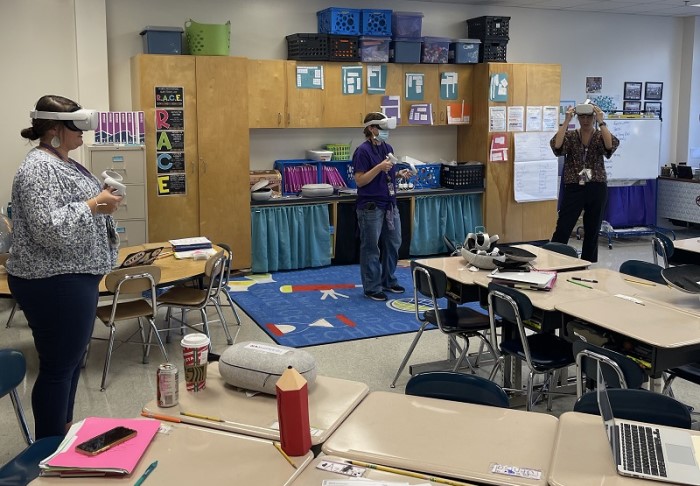
BY KARISSA MILLER
By 2025, almost 70 percent of jobs in North Carolina will require education beyond high school training.
In response to this need, Iredell-Statesville Schools’ Career Technical Education department has launched a virtual reality initiative to give fifth- and sixth-graders a fully-immersed look into high-demand industry jobs and fields.
“We really want to expose kids to as much as we can in fifth and sixth grade. That way they can begin to think about career opportunities — some linked through college, some certifications or degrees,” explained I-SS CTE Director Tim Woody.
The I-SS initiative offers a unique opportunity for students to be exposed to 28 career pathways, including robotics, engineering, manufacturing, first responders, hotel and tourism careers, quality assurance, automotive and carpentry.
Transfer VR is continuously adding new career programs onto the headsets for students to access. The software is licensed annually. The district has 10 VR headsets at this time.
The purchase, which did not involve any local funds from the district’s budget, was made through a federal Perkins grant. The license and headsets cost about estimated $10,000, officials stated.
“Instead of watching a video about a job or hearing a teacher present or talk, they actually are able to go into this Virtual Reality experience and try it on and navigate a pathway. It’s certainly cutting-edge technology,” Woody said.
I-SS Career Development Coordinator for Middle School Programs Juli Tipton works to help fifth-graders prepare for registering for sixth grade classes.
Tipton explained that middle school is a very exploratory time to try out different career and technical education classes. By helping students narrow their interest, they will then be able to make better class selections in high school, she added.
“Our ultimate goal is helping students find a career, or a skill or a job that can lead to a lifetime of being able to support them and in a career that they are happy with,” Tipton said.
“The Virtual Reality headsets give them a very hands-on, immersive experience to try out lots of skills and careers so that they can feel confident in a career choice,” she added.
Students will get to rate the programs and provide feedback if the career or trade is something that interested them. Tipton pointed out that 75 to 80 percent of I-SS students do not go on to a four-year school.
“This is an opportunity for them to learn about skill trades, advanced manufacturing and other options that are out there for that remaining 80 percent of students who don’t know what’s out there,” Tipton said.
Cutting edge technology benefits
In Iredell County, there are many advanced manufacturing jobs and not enough workers to fill those jobs.
“Employers are having a difficult time finding workers. They would like to get students straight out of high school and train them. This would help students explore it, experience it in simulation and between our apprenticeship and work-based learning opportunities connect them with employers here locally,” Tipton added.
Another benefit of the VR headsets is that students can learn in a safe environment.
“You’re able to repeat any simulation until you perfect something or are confident with your skill,” Tipton said.
I-SS is one of only a handful of school districts in the state are using VR headsets.
Virtual Reality and STEM learning
A few weeks ago, some of the teachers at Lakeshore Elementary School received training on the CTE virtual career headsets. Teachers had a lot of fun stepping into a 360-degree simulation where they can explore various careers.
Teachers cannot see what’s going on outside when they put the headsets on. However, with a few clicks, someone can watch someone in simulation through a Chromecast. This feature, Tipton said, will help with soft skills and build interpersonal relationships with others.
Principal Christopher Grace explained that teachers were learning how to use them so that they can use them with fifth-graders at the school.
“It was a perfect mix because we’re a STEM school,” Grace said. “We got together and plan on using them with students to get kids exposed to the careers that are out there for them.”
It also helps our STEM distinction with the state because we have to focus on post-secondary opportunities for kids, he added.



